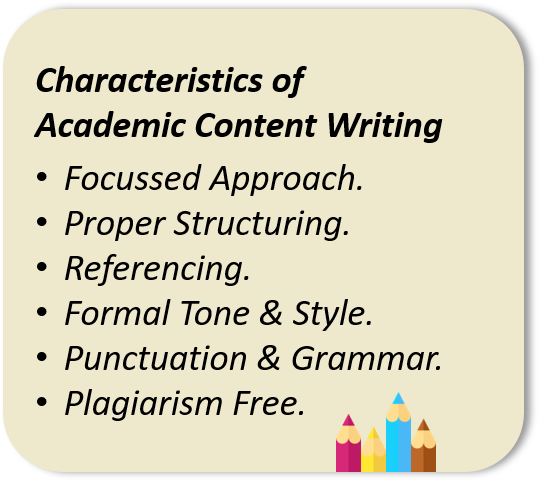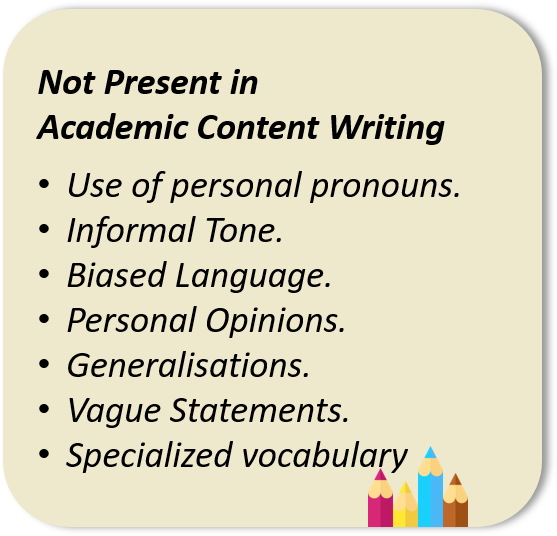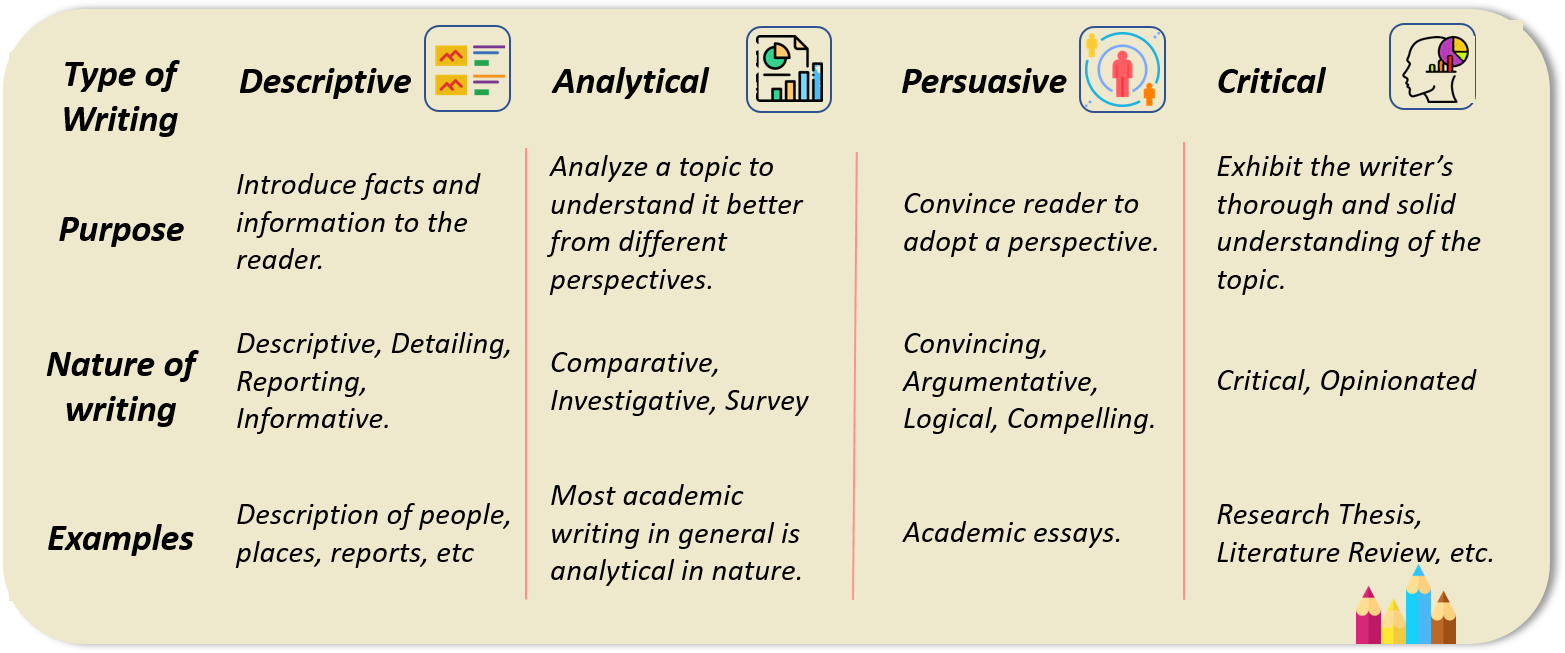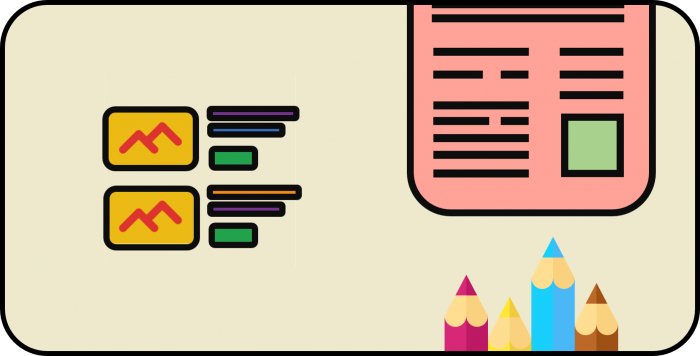Writing helps people communicate with each other. It lets people share their ideas, thoughts and feelings with other people. Writing has been with humanity for several thousand years. It is an outcome of the development of the human civilization and the first ever means to “record” human communication. It has evolved and grown from a general means of expression into a specialized form today. Academic content writing is one such specialized form of writing. Its purpose is to present technical content to the academia in a clear, focused and well-structured form. Academic writing has a distinct style, tone, language and structure. A piece of academic writing is replete with facts, logic and reasoning. Academic essays, experiment reports, research thesis, etc. are a few examples of academic writing.

Academic Writing vs. Content Writing
Content writing is very diverse. It does not have any distinct style, language or structure. Individual writers have their own styles, language and manner of writing. Readability is important since the content is for consumption by general readership, which is wide and varied. Most of the content that is available online (website, blogs, etc.) comes within the ambit of general content writing. The topics of the content may be daily news, sports, ecommerce, business, etc.
The goal of academic writing, on other hand, is to improve the technical knowledge of a reader. Developed by people from academia, academic writing is for consumption by an academic audience. The topics of discussion are from disciplines of academic study and research. There are several styles of academic writing, each of which is unique and used for a specific academic objective. This article focuses on academic content writing, its characteristics and its types.
The article: “Academic Writing” on the Massey University, New Zealand website offers more idea about Academic Writing in general.
Characteristics of Academic Content Writing

The usual goal of academic writing is to present the outcome of a research study. It is an attempt at apprising the academia about the subject of research, the study conducted to understand it and the research contribution made to it, if any. A piece of academic writing engages readers and draws them in, as participants in the process of discussion. Well written academic content does not culminate the process of thinking. It rather takes the process of thinking forward and further. Academic writing has a few characteristics which also serve as guidelines for an academic content writer. Described below are some of these characteristics.
Focused approach
The approach of the content is clear- persuasive, analytical, informative, etc. For Instance, a persuasive approach tries to convince the reader to develop a certain perspective. A combination of facts, reasoning and logic may help achieve the purpose. An informative approach attempts to educate the reader about a perspective. It does not persuade the reader to adopt a perspective.
Proper Structuring
The content is well structured. It follows a logical order- introduction, body paragraphs and concluding paragraph. A piece of academic writing presents ideas, thoughts, references, discussions, etc. in a manner that engages the reader. The content introduces the topics, discusses/analyzes it and then takes it to a meaningful conclusion. A piece of academic writing does not end abruptly or vaguely.
Referencing

Academic writing is rich in references drawn from subject literature. References and citations support facts. Inclusion of references in academic writing means that the writer is well informed of the existing research in the subject. Thus, referencing and citation lend credibility to academic writing.
Formal Tone, Style, Punctuation & Grammar
Academic writing has a distinct tone. It is simple but formal. Use of subjective language is avoided. The vocabulary is precise and spelled correctly. Abbreviations are usually avoided. Punctuation and grammar rules are strictly followed to ensure that the words and statements convey their intended meanings. All kinds of academic writing call for following a standard style guide.
Additionally, the use of personal nouns, informal tone, biased language, opinions, generalizations, verbosity, vague statements, specialized terminology and difficult vocabulary is not advisable. Academic writing is plagiarism free. Quality academic writing reflects academic integrity.
The articles: “Academic Writing” on the University of Leeds, UK website; “Organizing Your Social Sciences Research Paper: Academic Writing Style” on University of Southern California website; “Academic Writing Guide” by Annie Whitaker of the City University of Seattle at Bratislava, Slovakia offer more insight into the topic.
Types of Academic Writing
Academic writing is quite diverse in terms of the approach it reflects. The approach of a piece of academic writing can be descriptive, analytical, persuasive or critical. Depending on the purpose, the overall approach can be a combination of these individual approaches also.
The following discussion provides a brief description of each of these approaches.
Descriptive Writing
The objective of such writing is to introduce facts and information to the reader. It is one of the most simple forms of academic writing. A lab report that informs the reader about the results of an experiment is an example of descriptive writing. Descriptive writing is also used for describing people, places, situations, events, etc.
Analytical Writing
A piece of analytical writing generally includes- problem description, probable solutions to the problem, assessment of the different methods of solution and their comparison. The views expressed in the analysis are impartial. The writer cogitates over the facts and the ideas that relate to the problem and its solution. A piece of analytical writing may include graphs, flow-charts, diagrams to improve clarity of understanding. Different Styles of Academic Content Writing

Persuasive Writing
This writing style goes one step beyond analytical writing. A persuasive writing piece carries the view/perspective of the writer also. In fact, the writer attempts to convince the reader to adopt a perspective. To help achieve this objective, the writer uses arguments supported by reason and evidence. Academic essays are persuasive in nature. News editorials, advertisements, reviews of electronic gadgets, etc. have a persuasive writing style.
Critical Writing
This is the preferred writing style for research-oriented writing work. Critical writing takes more than one source of information to develop an argument. A piece of critical writing summarizes all/part of work on a topic, including interpretations, assumptions and methodology. The piece also carries an opinion of the work taken into account and the writer’s point of view on the topic. The content is rich in analysis and strongly evidenced. The writer has a thorough understanding of the topic and strong writing skills.
The “Writing” page on The University of Sydney website offers a detailed insight into academic content writing. The website: eapfoundation, offers more details on critical writing.
Another Classification of Academic Writing
Academic writing is also classified on the basis of the kind of writing that scholars do. Lab reports, case studies, literature reviews, research papers, book reports, bibliographies, research theses are just a few examples of documents found in an academic setting. Such documents follow a well-defined writing style in many institutions. Institutions provide clear guidelines to the academia regarding the kind of academic writing applicable for different documents. Besides academic writing, there are many diverse forms of content writing. Information pertaining to content writing and different ways of classifying it is available on the internet. A few websites that offer idea on the subject of content writing are: Owlcation, constantcontent and AdEspresso.
The documents: “How to Write a Thesis: A Working Guide” at the University of Western Australia and “Guidelines For Writing A Thesis Or Dissertation” at the College of Journalism and Communications, University of Florida website offer idea of the kind of guidelines advised for writing a thesis document.
Writing is an important skill. It helps improve an individual’s understanding of a topic. Writing also helps develop vocabulary and articulation skills. This article is part of a series of articles on Writing.
Image Credits:
Icons by prettycons, Freepik, geotatah, Smashicons at www.flaticon.com
For further reading related to pedagogy and education standards, please visit the blog pages at Evelyn Learning.
Create.Engage.Inspire















